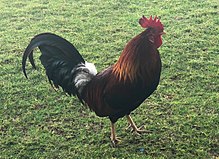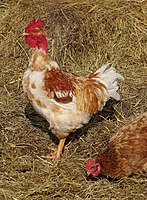| Revision as of 13:17, 19 December 2020 editJustlettersandnumbers (talk | contribs)Autopatrolled, Administrators121,009 edits rm some unreferenced content – Misplaced Pages is built on independent reliable sources; wl capon← Previous edit | Revision as of 13:23, 19 December 2020 edit undoJustlettersandnumbers (talk | contribs)Autopatrolled, Administrators121,009 edits rm some unreferenced content – Misplaced Pages is built on independent reliable sourcesNext edit → | ||
| Line 15: | Line 15: | ||
| == Reproduction == | == Reproduction == | ||
| Sperm transfer occurs by ]l contact between the male and female, in a maneuver known as the "cloacal kiss".<ref name="Briskie1997">{{cite journal|last=Briskie|first=J. V.|author2=R. Montgomerie |title=Sexual Selection and the Intromittent Organ of Birds|journal=Journal of Avian Biology|year=1997|volume=28|issue=1|pages=73–86 |doi=10.2307/3677097|jstor=3677097}}</ref> |
Sperm transfer occurs by ]l contact between the male and female, in a maneuver known as the "cloacal kiss".<ref name="Briskie1997">{{cite journal|last=Briskie|first=J. V.|author2=R. Montgomerie |title=Sexual Selection and the Intromittent Organ of Birds|journal=Journal of Avian Biology|year=1997|volume=28|issue=1|pages=73–86 |doi=10.2307/3677097|jstor=3677097}}</ref> | ||
| ==Crowing== | ==Crowing== | ||
| Line 24: | Line 24: | ||
| ] crowing. Note the characteristic neck bending that always takes place during crowing.]] | ] crowing. Note the characteristic neck bending that always takes place during crowing.]] | ||
| Roosters almost always start crowing before four months of age. Although it is possible for a hen to crow as well, crowing (together with hackles development) is one of the clearest signs of being a rooster.<ref>{{cite web|last=Read|first=Gina|title=Sexing Chickens|url=http://successwithpoultry.blogspot.co.uk/2008/07/sexing-chickens.html|work=Keeping Chickens Newsletter|publisher=keepingchickensnewsletter.com|access-date=5 July 2008}}</ref> | Roosters almost always start crowing before four months of age. Although it is possible for a hen to crow as well, crowing (together with hackles development) is one of the clearest signs of being a rooster.<ref>{{cite web|last=Read|first=Gina|title=Sexing Chickens|url=http://successwithpoultry.blogspot.co.uk/2008/07/sexing-chickens.html|work=Keeping Chickens Newsletter|publisher=keepingchickensnewsletter.com|access-date=5 July 2008}}</ref> | ||
| The rooster is often portrayed as crowing at the break of dawn ("cock-a-doodle-doo"). However, while many roosters crow shortly after waking up, this idea is not exactly true. A rooster can and will crow at any time of the day. Some roosters are especially vociferous, crowing almost constantly, while others only crow a few times a day. These differences are dependent both upon the rooster's breed and individual personality. A rooster can often be seen sitting on fence posts or other objects, where he crows to proclaim his territory. | |||
| Roosters have several other calls as well, and can cluck, similar to the hen. Roosters occasionally make a patterned series of clucks to attract hens to a source of food, the same way a mother hen does for her chicks. | |||
| ===Rooster crowing contests=== | ===Rooster crowing contests=== | ||
| Line 36: | Line 32: | ||
| ] | ] | ||
| A cockfight is a contest held in a ring called a cockpit between two ]s or cocks, with the first use of the word gamecock (denoting use of the cock in game, sport, pastime or entertainment) appearing in 1646.<ref> – first use of word – 1646</ref> after the term "cock of the game" used by George Wilson, in the earliest known book on the secular sport of ]ing in ''The Commendation of Cocks and Cock Fighting'' in 1607. Gamecocks are not typical farm chickens. The cocks are specially ] and trained for increased stamina and strength. The comb and ] are removed from a young gamecock because, if left intact, they would be a disadvantage during a match. This process is called ]. Sometimes the cocks are given drugs to increase their stamina or thicken their blood, which increases their chances of winning. Cockfighting is considered a traditional sporting event by some, and an example of ] by others and is therefore outlawed in most countries.<ref>{{cite news|url=http://archives.cnn.com/2002/ALLPOLITICS/11/26/cf.opinion.cockfighting/index.html |title=Should cockfighting be outlawed in Oklahoma? |date=26 November 2002 |access-date=17 August 2009 |work=CNN |url-status=dead |archive-url=https://web.archive.org/web/20090619150618/http://archives.cnn.com/2002/ALLPOLITICS/11/26/cf.opinion.cockfighting/index.html |archive-date=19 June 2009}}</ref> Usually wagers are made on the outcome of the match, with the surviving or last-bird-standing being declared the winner. | A cockfight is a contest held in a ring called a cockpit between two ]s or cocks, with the first use of the word gamecock (denoting use of the cock in game, sport, pastime or entertainment) appearing in 1646.<ref> – first use of word – 1646</ref> after the term "cock of the game" used by George Wilson, in the earliest known book on the secular sport of ]ing in ''The Commendation of Cocks and Cock Fighting'' in 1607. Gamecocks are not typical farm chickens. The cocks are specially ] and trained for increased stamina and strength. The comb and ] are removed from a young gamecock because, if left intact, they would be a disadvantage during a match. This process is called ]. Sometimes the cocks are given drugs to increase their stamina or thicken their blood, which increases their chances of winning. Cockfighting is considered a traditional sporting event by some, and an example of ] by others and is therefore outlawed in most countries.<ref>{{cite news|url=http://archives.cnn.com/2002/ALLPOLITICS/11/26/cf.opinion.cockfighting/index.html |title=Should cockfighting be outlawed in Oklahoma? |date=26 November 2002 |access-date=17 August 2009 |work=CNN |url-status=dead |archive-url=https://web.archive.org/web/20090619150618/http://archives.cnn.com/2002/ALLPOLITICS/11/26/cf.opinion.cockfighting/index.html |archive-date=19 June 2009}}</ref> Usually wagers are made on the outcome of the match, with the surviving or last-bird-standing being declared the winner. | ||
| ==The cockerel "waltz"== | |||
| ] | |||
| The cockerel "waltz", when the cockerel struts in a half circle with one wing extended down, is an aggressive approach signifying to females his dominance, and usually, the female will submit by running or moving away from the cockerel in acknowledgement. On rare occasions, the hen will attempt to fight the cockerel for dominance. Once dominance is established, the cockerel will rarely waltz again. When other cockerels are in the hen yard, this waltz is used significantly more and most cockerels will waltz together if dominance has not been established; either one will back off, or the two cockerels will fight. The cockerel will waltz again if he is taken out of the pen for a period, usually 24 hours, and put back. | |||
| Some more aggressive cockerels will drop and extend both wings and puff out all their body feathers to give the hens or other cocks the impression of a larger size, and charge through the hen yard. | |||
| ==Image gallery== | ==Image gallery== | ||
Revision as of 13:23, 19 December 2020
Male chicken For other uses, see Rooster (disambiguation). "Cockadoodledoo" and "Cocka-doodle-doo" redirect here. For the nursery rhyme, see Cock a doodle doo.

A rooster or cock is the adult male chicken, Gallus gallus domesticus. A younger male may be called a cockerel; a male that has been castrated is a capon.
There are numerous cultural references to cocks and cockerels, in myth, folklore and religion, in language and in literature.
Etymology
According to Merriam-Webster, the term "rooster" (i.e. a roosting bird) originated in the mid- or late 18th century as a euphemism to avoid the sexual connotation of the original English "cock", and is widely used throughout North America. "Roosting" is the action of perching aloft to sleep at night, which is done by both sexes.
Reproduction
Sperm transfer occurs by cloacal contact between the male and female, in a maneuver known as the "cloacal kiss".
Crowing



Roosters almost always start crowing before four months of age. Although it is possible for a hen to crow as well, crowing (together with hackles development) is one of the clearest signs of being a rooster.
Rooster crowing contests
Rooster crowing contests are a traditional sport in several countries, such as Germany, the Netherlands, Belgium, the United States, Indonesia and Japan. The oldest contests are held with longcrowers. Depending on the breed, either the duration of the crowing or the times the rooster crows within a certain time is measured.
Cockfighting
Main article: Cockfight
A cockfight is a contest held in a ring called a cockpit between two gamecocks or cocks, with the first use of the word gamecock (denoting use of the cock in game, sport, pastime or entertainment) appearing in 1646. after the term "cock of the game" used by George Wilson, in the earliest known book on the secular sport of cockfighting in The Commendation of Cocks and Cock Fighting in 1607. Gamecocks are not typical farm chickens. The cocks are specially bred and trained for increased stamina and strength. The comb and wattle are removed from a young gamecock because, if left intact, they would be a disadvantage during a match. This process is called dubbing. Sometimes the cocks are given drugs to increase their stamina or thicken their blood, which increases their chances of winning. Cockfighting is considered a traditional sporting event by some, and an example of animal cruelty by others and is therefore outlawed in most countries. Usually wagers are made on the outcome of the match, with the surviving or last-bird-standing being declared the winner.
Image gallery
-
 A rooster
A rooster
-
 A full grown rooster
A full grown rooster
-
 An Indian rooster
An Indian rooster
-
 A Sussex rooster
A Sussex rooster
-
 Naked Neck rooster in France
Naked Neck rooster in France
-
 Two roosters about to fight
Two roosters about to fight
-
 Bantam rooster
Bantam rooster
-
 Polish chicken
Polish chicken
-
 Crowing Berg crower
Crowing Berg crower
-

-
 Brown Leghorn rooster
Brown Leghorn rooster
-
 Faverolles chicken and female
Faverolles chicken and female
-
Cock fountaine of the "Bosquet du Labyrinth" in Versailles.
See also
References
- https://www.merriam-webster.com/dictionary/rooster
- Hugh Rawson "Why Do We Say...? Rooster", American Heritage, Aug./Sept. 2006.
- Online Etymology Dictionary Entry for rooster (n.), May 2019
- Briskie, J. V.; R. Montgomerie (1997). "Sexual Selection and the Intromittent Organ of Birds". Journal of Avian Biology. 28 (1): 73–86. doi:10.2307/3677097. JSTOR 3677097.
- Read, Gina. "Sexing Chickens". Keeping Chickens Newsletter. keepingchickensnewsletter.com. Retrieved 5 July 2008.
- Cock crowing contest recognised as National Heritage in Belgium Stefaan De Groote, Het Nieuwsblad, 27. June 2011 (in Dutch). Accessed October 2015
- gamecock - Merriam-Webster Online Dictionary – first use of word – 1646
- "Should cockfighting be outlawed in Oklahoma?". CNN. 26 November 2002. Archived from the original on 19 June 2009. Retrieved 17 August 2009.
External links
![]() Media related to Roosters at Wikimedia Commons
Media related to Roosters at Wikimedia Commons
| Heraldry | |||||||||||||||
|---|---|---|---|---|---|---|---|---|---|---|---|---|---|---|---|
| Types | |||||||||||||||
| Topics | |||||||||||||||
| Achievement | |||||||||||||||
| Charges | |||||||||||||||
| Tinctures |
| ||||||||||||||
| Applications | |||||||||||||||
| Related | |||||||||||||||
| |||||||||||||||